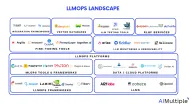5 Key Benefits of MLOps Practices for Businesses in 2024
MLOps is a method based on adapting DevOps practices to machine learning development processes. MLOps is useful in transitioning from running a couple of ML models manually to using ML models in the entire company operation. Overall, MLOps helps you improve delivery time, reduce defects, and make data science more productive. In this article, we’ll explain key points on how MLOps can benefit your company’s workflow.
1. Productivity
MLOps increases the productivity of all processes within the ML lifecycle by:
Creating automated pipelines
There are many labor-intensive and repetitive tasks within the ML lifecycle. For instance, data scientists spent nearly half of their time getting the data ready for the model. Manual data collection and preparation are inefficient and can lead to suboptimal results.
MLOps stands for automating the entire workflow of the ML model. This covers all the actions from data collection to model development, testing, retraining, and deployment. MLOps practices save time for teams and prevent human-induced errors. In this way, teams can engage in more value-added efforts rather than repetitive tasks.
Standardizing ML workflows for efficient collaboration
Company-wide adoption of ML models requires collaboration between not just data scientists and engineers but also IT and business professionals. MLOps practices enable businesses to standardize the ML workflows and create a common language for all stakeholders. This minimizes incompatibility issues and speeds up the entire process from creation to deployment of models.
2. Reproducibility
Automating ML workflows provides reproducibility and repeatability in many aspects, including how ML models are trained, evaluated, and deployed. This makes continuously trained models dynamic and integrated into change:
- Data versioning: MLOps ensures storing different versions of data that were created or changed at specific points in time and saving snapshots of different versions of data sets.
- Model versioning: MLOps practices involve creating feature stores for different types of model features and versioning the model with different hyperparameters and model types.
3. Reliability
By incorporating CI/CD principles from DevOps into the machine learning processes, MLOps makes ML pipelines more reliable. Automated ML lifecycle minimizes human errors and companies gain realistic data and insights.
One of the biggest challenges of ML development is scaling from a small model to a large production system. MLOps streamlines model management processes to enable reliable scaling.
4. Monitorability
Monitoring the behavior and performance of ML models is essential because models drift over time as the environment changes. MLOps enable businesses to monitor and get insights about model performance systematically by:
- Retraining the model continuously: ML models are monitored and automatically retrained periodically or after a certain event. The purpose of retraining a model is to ensure that it consistently provides the most accurate output.
- Sending automated alerts to staff in case of model drift: MLOps gives the business real-time status of your data and model and alerts the relevant employees if the model performance degrades below a certain threshold. Thus, it enables you to take quick actions against model degradation.
5. Cost Reduction
MLOps can significantly reduce costs over the entire machine learning lifecycle:
- Automation minimizes the manual efforts to manage machine learning models. This will free up employee time which can be used for more productive tasks.
- It enables you to detect and reduce errors more systematically. Decreased errors during model management will also translate to reduced costs.
For instance, Ntropy announced that it has reduced its infrastructure test costs by 8X with MLOps solutions.
If you want to get started with MLOps in your business, you can check our data-driven list of MLOps platforms. If you have other questions, we can help:

Cem has been the principal analyst at AIMultiple since 2017. AIMultiple informs hundreds of thousands of businesses (as per similarWeb) including 60% of Fortune 500 every month.
Cem's work has been cited by leading global publications including Business Insider, Forbes, Washington Post, global firms like Deloitte, HPE, NGOs like World Economic Forum and supranational organizations like European Commission. You can see more reputable companies and media that referenced AIMultiple.
Throughout his career, Cem served as a tech consultant, tech buyer and tech entrepreneur. He advised businesses on their enterprise software, automation, cloud, AI / ML and other technology related decisions at McKinsey & Company and Altman Solon for more than a decade. He also published a McKinsey report on digitalization.
He led technology strategy and procurement of a telco while reporting to the CEO. He has also led commercial growth of deep tech company Hypatos that reached a 7 digit annual recurring revenue and a 9 digit valuation from 0 within 2 years. Cem's work in Hypatos was covered by leading technology publications like TechCrunch and Business Insider.
Cem regularly speaks at international technology conferences. He graduated from Bogazici University as a computer engineer and holds an MBA from Columbia Business School.
To stay up-to-date on B2B tech & accelerate your enterprise:
Follow on

Comments
Your email address will not be published. All fields are required.